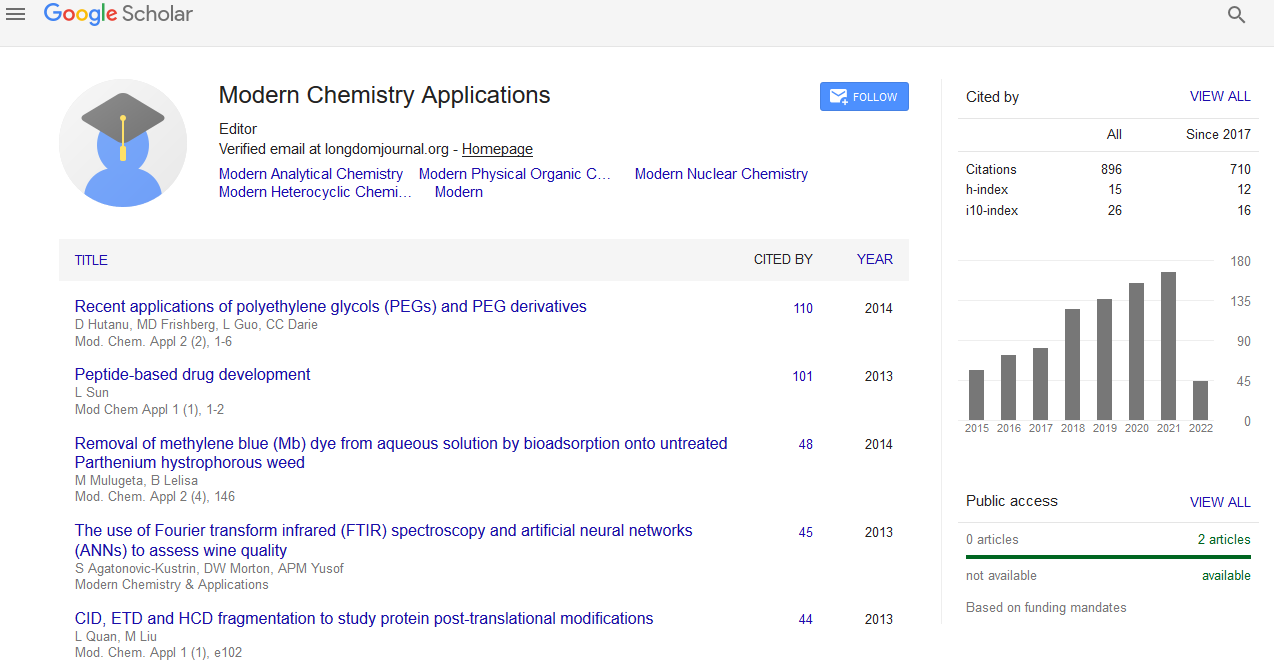Indexed In
- Open J Gate
- JournalTOCs
- RefSeek
- Hamdard University
- EBSCO A-Z
- OCLC- WorldCat
- Scholarsteer
- Publons
- Geneva Foundation for Medical Education and Research
- Google Scholar
Useful Links
Share This Page
Journal Flyer

Open Access Journals
- Agri and Aquaculture
- Biochemistry
- Bioinformatics & Systems Biology
- Business & Management
- Chemistry
- Clinical Sciences
- Engineering
- Food & Nutrition
- General Science
- Genetics & Molecular Biology
- Immunology & Microbiology
- Medical Sciences
- Neuroscience & Psychology
- Nursing & Health Care
- Pharmaceutical Sciences
Synthesis and antioxidant activity of 2-mercaptothienopyrimidine-tethered-1,2,3-triazoles
5th Global Chemistry Congress
September 04-06, 2017 | London, UK
Parvesh Singh and Nagaraju Kerru
University of Kwa-Zulu Natal, South Africa
Posters & Accepted Abstracts: Mod Chem Appl
Abstract:
Thienopyrimidines are known to possess a wide-spectrum of medicinal activities including anti-TB, anti-cancer, antibacterial, anti-fungal, anti-oxidant, and anti-diabetic activities. Similarly 1, 2, 3-triazole nucleus has been exploited in the design of several medicinally and biologically active scaffolds including anti-oxidant compounds. Among different synthetic approaches being used in the drug discovery, molecular hybridization (MH) is gaining popularity owing to its ability to combine two or more bioactive scaffolds with different or novel mechanism of action. In view of the aforementioned significance of thienopyrimidine and 1,2,3-triazoline scaffolds, it was thought worthwhile to couple these two pharmacophores in a single molecular architecture to check the anti-oxidant effect of the resultant molecular hybrid. Accordingly, the desired molecular hybrids (5a-f and 6a-f) were prepared by copper catalyzed cycloaddition of alkynyl thienopyrimidine with various substituted aryl azides in the presence of CuSO4 and sodium ascorbate in THF/H2O (1:1). The synthesized compounds screened for their antioxidant activity using DPPH radical scavenging, NO and ABTS assays revealed several promising molecular conjugates with excellent antioxidant activity, even better than the standard drug (acarbose). The structure activity relationship studies further revealed the role of electron-donating (-CH3, Cl, I) groups in increasing the anti-oxidant activity of the compounds, whereas an opposite effect was observed for the electron-withdrawing substituents.
Biography :
Parvesh Singh received his PhD degree in Organic Chemistry from the Guru Nanak Dev University, India. Currently, he is working as a Senior Lecturer of Organic Chemistry at University of KwaZulu Natal (South Africa). His research interests involve the synthesis, biological evaluation and molecular modeling of heterocyclic scaffolds. He is primarily using hetero Diels-Alder methodology to synthesize heterocyclic rings of different sizes. He has published 60 research articles in peerreviewed journals of international repute including a book chapter and a book.


